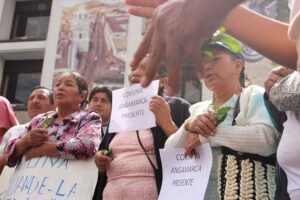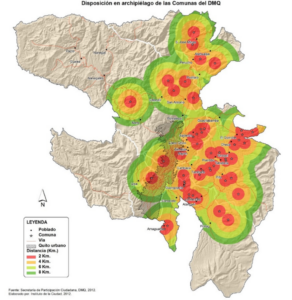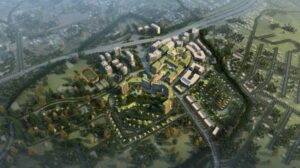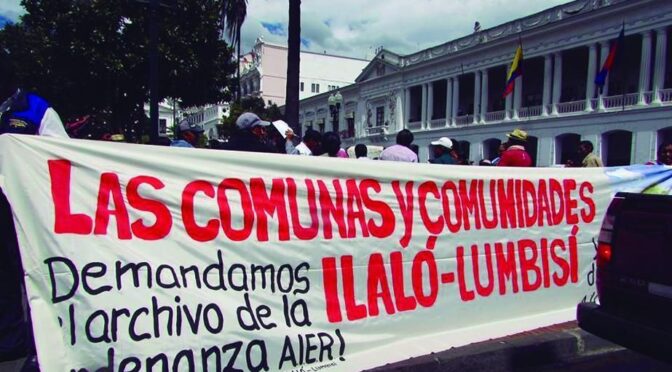Preventing erasure through self-governance in the Comunas of Quito, Ecuador.
By Kaileen McHugh
Introduction
Within the Municipality of Quito lie distinct, autonomous communities with unique governance structures and internal planning processes. These comunas generally practice traditional ways of living founded on indigenous principles, including communal ownership of land and assembly-based participatory democracy. However, despite constitutional language dating back to the 1930’s and more recently in 2008 that granted comunas collective rights to property, their own production systems and governance models, and even exemptions to taxes, these communities still have to fight hard for recognition from the “plurinational” state that they supposedly exist concurrently with.
In 2015, comunas on the south side of the Valle de Tumbaco located in eastern Quito faced such a challenge when the municipality adopted an ordinance to turn land occupied by several comunas into an ecological site. The planning process of this ordinance (the Special Area of Ecological Intervention and Recuperation (AIER) Ilaló-Lumbisí) included space for the comunas to participate, and led the comunas and municipality to agree on certain goals such as constraining real estate development and preserving the natural environment. However, the municipality expected the comunas to come to them and for those that did, their participation in forums were considered “…authorization for subsequent decisions” (Rayner, 2017). In the end, the municipality did not consider the comunas’ internal planning processes or respect their long-term needs. The comunas responded with a collective opposition to the ordinance, and through organized pressure on the municipality they succeeded in halting the AIER process.
Analysis
A main tension between the state and the comunas stems from conflicting understanding of property rights. Communal land ownership practices within the comunas are often misunderstood and ignored by the Municipality of Quito. Despite constitutional law allowing for the existence of such practices, the municipality ultimately considers these practices ‘informal’, leading to the state-sanctioned disempowerment of comunas and unraveling of the plurinational state.
According to Roy, the state has the power to decide what is formal and informal and these ideals are obtained from the developed world and western concepts (Roy, 2005). In the case of Quito, private property and real estate practices are formal, while communal land ownership practices are informal. Across the city, the municipality has pushed this formality through campaigns to “Regularize Your Neighborhood” by providing private land titles and services to those who comply (Rayner, 2017). The municipality does this in an attempt to “…restore “order” to the urban landscape or to bring it into the fold of formal markets” (Roy, 2005) (Kamete, 2013).
In the case of comunas affected by the ordinance AIER Ilaló- Lumbisí, the “disorder” existing within their land as described by the municipality was an unregulated real estate market and growing ecological concerns over pollution and forest fires (Morales & Fernandez-Muro, 2016). These conditions of “disorder” and “informality” prescribed by state officials (per Kamete 2013) provided the rationale to “convert” the land into an ecological site. This designation further strips already-vulnerable rights from comunas and disempowers them from making autonomous decisions on land use such as housing for future generations or cultivation.
At the same time, the municipality permits development when it occurs in the formal sphere. The municipality was happy to oblige private developers and investors who built a large office and hotel complex around the Ilaló hill (the proposed ecological site), yet ironically the passage of AIER Ilaló- Lumbisí would have prohibited comunas from building in the same site. The private sector is given exceptions in this instance; they are able to influence urban land use and development patterns as “arranged urbanism” and insert themselves into official plans that may break formal regulations (Koch, 2015). Again, the state is deciding what is formal or allowable here. The activities that conform to western ideals and produce spaces that embody these ideas are considered “permissible” or “acceptable” (Kamete, 2013).
Fortunately, the affected comunas’ strong assembly-based democratic practices led them to take a unified stance against the ordinance and create the Federation of Comunas of Ilaló- Lumbisí. Such self-governance, as described by Nunbogu et al, “refers to the freedom with which individuals and communities undertake initiatives and coordinate their actions for accomplishing a set of objectives” (Nunboga, Korah, Cobbinah, & Poku-Boansi, 2018). This concept enables communities to break open traditional planning systems to allow for more diverse urban configuration. The bottom-up model of organizing assemblies and debates enabled the comunas to bring forth their own comprehensive planning proposal, Plan de Vida. In this they list their own set of demands both in response to the ordinance and to the municipality’s general practices. Eventually, the pressure by the Federation of Comunas led the municipality to archive the ordinance and commit to a collaborative planning process.
Implications
Despite the plurinational, post-neoliberal context, the City of Quito continues to practice a model of participatory neoliberal governance that does not create a true dialogue between the state and communities. The participatory process of the municipality can be understood as a form of invited space legitimized by city authorities, where autonomy and innovation are denied (Miraftab, 2009).
This case study shows that self-governance models that counter the hegemonic practices of the state provide important lessons for planning. The state should not only provide room for these models and collective actions but should also implement the result of internal planning processes into official policymaking and implementation. At the same time, planners need to shift away from being the main actors and decision makers in these processes and instead serve as facilitators who embrace grassroots initiatives led by community (Nunboga, Korah, Cobbinah, & Poku-Boansi, 2018).
Planners also need to reconsider their rationalities surrounding formal vs informal spaces. Kamete explains that planners fail at creating participatory methods because they are focused on the rational and technical models they are trained in, and do not consider relational governance. These models ignore conditions of land specific to place, like community histories and land tenure, and may lead to the erasure of particularities of space (Rugkhapan, 2017). The case of the comunas in Quito confirms the need for a deeper cultural exchange in planning, coupled with an understanding that technical rationality by itself is insufficient in bringing about positive change.

Protests by the comunas of Ilaló and Lumbisí against the Quito municipal government in 2015. See Source Here.

Protests by the comunas of Ilaló and Lumbisí against the Quito municipal government in 2015. See Source Here.

Map showing location of indigenous comunas in Quito. See Source Here.

Proposed development on Ilaló hill, Quito. See Source Here.
